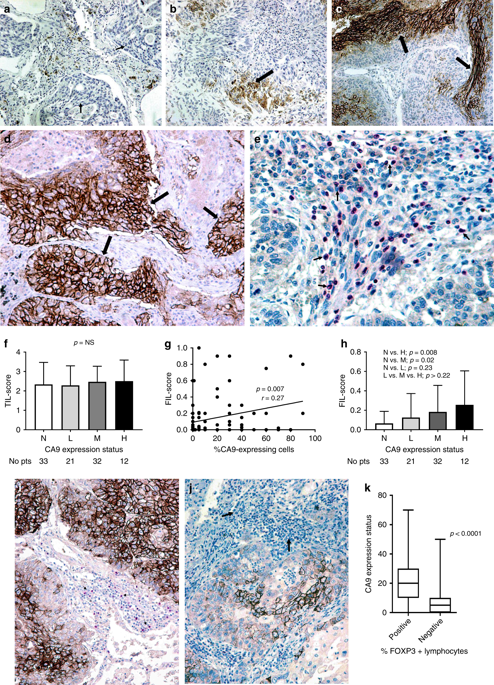当前位置:
X-MOL 学术
›
Br. J. Cancer
›
论文详情
Our official English website, www.x-mol.net, welcomes your
feedback! (Note: you will need to create a separate account there.)
Carbonic anhydrase 9 (CA9) expression in non-small-cell lung cancer: correlation with regulatory FOXP3+T-cell tumour stroma infiltration.
British Journal of Cancer ( IF 6.4 ) Pub Date : 2020-02-18 , DOI: 10.1038/s41416-020-0756-3 Alexandra Giatromanolaki 1 , Adrian L Harris 2 , Alison H Banham 3 , Constantinos A Contrafouris 4 , Michael I Koukourakis 5
British Journal of Cancer ( IF 6.4 ) Pub Date : 2020-02-18 , DOI: 10.1038/s41416-020-0756-3 Alexandra Giatromanolaki 1 , Adrian L Harris 2 , Alison H Banham 3 , Constantinos A Contrafouris 4 , Michael I Koukourakis 5
Affiliation

|
BACKGROUND
Low pH suppresses the proliferation and cytotoxic activity of CD8+ cytotoxic and natural killer lymphocytes. The hypoxia-regulated transmembrane protein, carbonic anhydrase CA9, converts carbon dioxide produced by the Krebs cycle to bicarbonate and protons that acidify the extracellular milieu. We examined whether CA9 is also involved in intratumoural immunosuppression pathways.
METHODS
A series of 98 tissue samples of primary non-small-cell lung carcinomas (NSCLC) from patients treated with surgery were analysed for the expression of CA9 and programmed-death ligand PD-L1 by cancer cells, and of FOXP3 by tumour-infiltrating lymphocytes (TILs).
RESULTS
There was no direct association of CA9 with PD-L1 expression or the density of TILs in the tumour stroma, but CA9 was directly related to the extent of FOXP3+ TIL density (p = 0.008). Double-stratification survival analysis showed that patients with high CA9 expression and low TIL score had significantly poorer survival compared with all other groups (p < 0.04). In a multivariate analysis stage (p < 0.0001, HR 1.95, 95% CI: 1.3-2.7), TIL score (p = 0.05, HR 0.55, 95% CI: 0.2-1.0) was an independent prognostic variable of death events. CA9 expression by cancer cells is associated significantly with FOXP3+ regulatory T-cell abundance in the tumour stroma of NSCLC.
CONCLUSION
The study provides a basis for testing CA9 as a marker of resistance to immune-checkpoint inhibitors and as a therapeutic target to enhance the efficacy of immunotherapy.
中文翻译:

非小细胞肺癌中碳酸酐酶 9 (CA9) 的表达:与调节性 FOXP3+T 细胞肿瘤基质浸润的相关性。
背景低pH抑制CD8+细胞毒性淋巴细胞和自然杀伤淋巴细胞的增殖和细胞毒性活性。缺氧调节跨膜蛋白碳酸酐酶 CA9 将克雷布斯循环产生的二氧化碳转化为碳酸氢盐和质子,从而酸化细胞外环境。我们检查了 CA9 是否也参与肿瘤内免疫抑制途径。方法 对来自手术治疗患者的 98 个原发性非小细胞肺癌 (NSCLC) 组织样本进行分析,分析癌细胞中 CA9 和程序性死亡配体 PD-L1 的表达,以及肿瘤浸润中 FOXP3 的表达。淋巴细胞(TIL)。结果 CA9 与肿瘤基质中 PD-L1 表达或 TIL 密度没有直接关联,但 CA9 与 FOXP3+ TIL 密度范围直接相关 (p = 0.008)。双分层生存分析显示,与所有其他组相比,CA9 高表达和 TIL 评分低的患者的生存率显着较差 (p < 0.04)。在多变量分析阶段(p < 0.0001,HR 1.95,95% CI:1.3-2.7),TIL 评分(p = 0.05,HR 0.55,95% CI:0.2-1.0)是死亡事件的独立预后变量。癌细胞的 CA9 表达与 NSCLC 肿瘤基质中 FOXP3+ 调节性 T 细胞的丰度显着相关。结论 该研究为测试 CA9 作为免疫检查点抑制剂耐药性标志物和作为增强免疫疗法疗效的治疗靶点提供了基础。
更新日期:2020-02-18
中文翻译:

非小细胞肺癌中碳酸酐酶 9 (CA9) 的表达:与调节性 FOXP3+T 细胞肿瘤基质浸润的相关性。
背景低pH抑制CD8+细胞毒性淋巴细胞和自然杀伤淋巴细胞的增殖和细胞毒性活性。缺氧调节跨膜蛋白碳酸酐酶 CA9 将克雷布斯循环产生的二氧化碳转化为碳酸氢盐和质子,从而酸化细胞外环境。我们检查了 CA9 是否也参与肿瘤内免疫抑制途径。方法 对来自手术治疗患者的 98 个原发性非小细胞肺癌 (NSCLC) 组织样本进行分析,分析癌细胞中 CA9 和程序性死亡配体 PD-L1 的表达,以及肿瘤浸润中 FOXP3 的表达。淋巴细胞(TIL)。结果 CA9 与肿瘤基质中 PD-L1 表达或 TIL 密度没有直接关联,但 CA9 与 FOXP3+ TIL 密度范围直接相关 (p = 0.008)。双分层生存分析显示,与所有其他组相比,CA9 高表达和 TIL 评分低的患者的生存率显着较差 (p < 0.04)。在多变量分析阶段(p < 0.0001,HR 1.95,95% CI:1.3-2.7),TIL 评分(p = 0.05,HR 0.55,95% CI:0.2-1.0)是死亡事件的独立预后变量。癌细胞的 CA9 表达与 NSCLC 肿瘤基质中 FOXP3+ 调节性 T 细胞的丰度显着相关。结论 该研究为测试 CA9 作为免疫检查点抑制剂耐药性标志物和作为增强免疫疗法疗效的治疗靶点提供了基础。















































 京公网安备 11010802027423号
京公网安备 11010802027423号